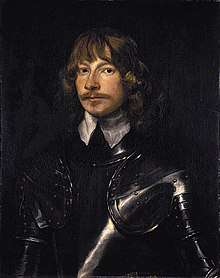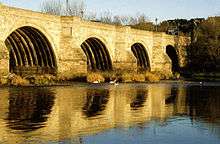Battle of the Brig of Dee
The Battle of the Brig of Dee took place on 18–19 June 1639 at the Bridge of Dee in Scotland. It was the only serious action in the First Bishops' War, and therefore the first serious action in the Wars of the Three Kingdoms. It was also the first serious action fought by James Graham, 5th Earl of Montrose, an important commander in these wars. Montrose led the Covenanters, who won, and James Gordon, 2nd Viscount Aboyne led the Royalists.
Background
In the 1630s, King Charles attempted to force religious reformation in Scotland, aiming to increase his control of the Scottish church through the bishops, and bring it inline with the English church. When he attempted to introduce a new prayer book into Scotland in 1637, there was significant resistance to the move. Those opposed to the new book signed a Covenant, hoping to force Charles to relent. He did, belatedly, offer to withdraw the prayer book, along with other concessions, but opposition to him had grown to such a level that the concessions were rejected, and instead the Scottish church voted to abolish bishops. Charles opted to seek a military solution, and began the First Bishops' War, hoping that an army of over 40,000 men could be gathered from England, Scotland and Ireland, and that in the face of such a force, the Scots would submit without engaging in battle.[1]
Prelude
Although the main confrontation was at the border, the north-east of Scotland was a Royalist stronghold in the Covenanters' rear. It had already been the scene of some military manoeuvres without serious fighting.
After a failed offensive at Megray Hill on 15 June, James Gordon, Viscount Aboyne retreated to Aberdeen,[2] but was split from the main body of his army: most of it was stranded on the other side of the River Dee, and between the two was James Graham, Earl of Montrose and his Covenanter army.[3] In Aberdeen, Aboyne retained around 180 mounted troops, and even less infantry.[4] The Covenanters were approaching Aberdeen from the south, and in response, Aboyne posted a hundred musketeers on the bridge, commanded by Lieutenant Colonel Johnstone.[3] At the southern entrance to the bridge, the gates were reinforced with an earthwork of "turfs and earth, as much as the shortness of the time would permit," and the Royalist cavalry was also posted to the bridge. Rain had swollen the river itself, making it impassable.[5]
Battle

On 18 June, the Covenanter army, numbering 2,000 infantry, 300 horse and artillery, reached the bridge and began their attack, primarily relying on their artillery. Firing on the barricade all through the day had minimal impact, and Montrose observed that efforts the next day produced no further breakthrough. He sent a troop of cavalry up the river, feigning that they would attempt to cross. Aboyne fell for the ruse, and deployed his entire cavalry to counteract the supposed attack. The Covenanters renewed their attack on the bridge, and Johnstone was injured by shrapnel. Johnstone and his musketeers retreated from the defence, allowing the attackers to capture the bridge.[6]
Once Aboyne saw that the bridge had been taken, he withdrew from Aberdeen towards Strathbogie. Both sides suffering around fourteen fatalities during the battle.[7]
Aftermath
The Covenanters took Aberdeen, though the city remained more sympathetic to the beaten Royalists, and many of the Covenanters proposed razing the city, which Montrose prevented. The day after the victory, Montrose received news that the Treaty of Berwick had been agreed, ending the First Bishops' War.[7]
In fiction
An account of the battle appears in The Young Montrose, a historical novel by Nigel Tranter.[8] It is also the setting for the ballad Bonny John Seton[9] (Child Ballad no. 198).
Notes
- Gaunt 1997, pp. 18–22.
- Jaques 2007, p. 650.
- Browne 1834, p. 326.
- Manganiello 2004, p. 1.
- Napier 1838, p. 289.
- Browne 1834, pp. 326–327.
- Browne 1834, p. 327.
- Tranter 1972, p. 24.
- Buchan 1985, pp. 443–444.
References
- Buchan, David (1985). "The Historical Ballads of the Northeast of Scotland". Lares. 51 (4): 443–451. JSTOR 44628673.CS1 maint: ref=harv (link)
- Browne, James (1834). History of the Highlands & of the Highland Clans, Volume 1, Part 2. Glasgow: A Fullarton & Co. OCLC 653943490.CS1 maint: ref=harv (link)
- Gaunt, Peter (1997). The British Wars 1637–1651. London: Routledge. ISBN 0-415-12966-4.CS1 maint: ref=harv (link)
- Jaques, Tony (2007). Dictionary of Battles and Sieges: F–O. London: Greenwood Press. ISBN 978-0-313-33536-5.CS1 maint: ref=harv (link)
- Manganiello, Stephen C. (2004). The Concise Encyclopedia of the Revolutions and Wars of England, Scotland, and Ireland, 1639–1660. Lanham, Maryland: The Scarecrow Press. ISBN 0-8108-5100-8.CS1 maint: ref=harv (link)
- Napier, Mark (1838). Montrose and the Covenanters. London: James Duncan. OCLC 831420716.CS1 maint: ref=harv (link)
- Tranter, Nigel (1972). The Young Montrose. London: Hodder & Stoughton. ISBN 978-1-4447-4104-9.CS1 maint: ref=harv (link)
Further reading
- Buchan, John (1928) The Marquis of Montrose p. 41
- Hastings, Max (1977) Montrose: The King's Champion
- Royle, Trevor (2005) Civil War: The Wars of the Three Kingdoms, 1638–1660 Abacus. ISBN 978-0-349-11564-1. pp. 91–93
External links
- Online account of First Bishops' War
- text of Bonny John Seton at Wikisource
